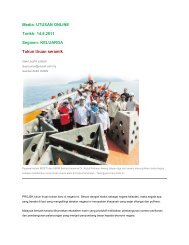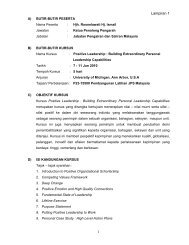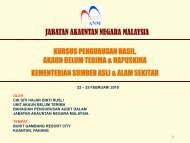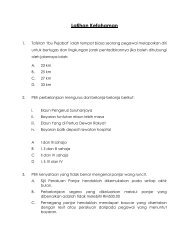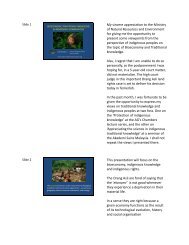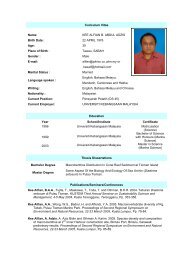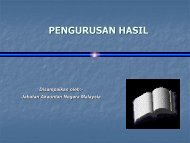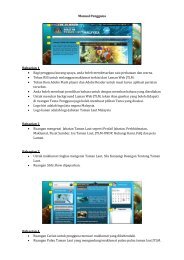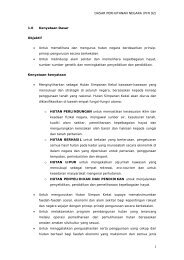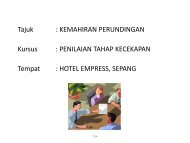Malaysian Biosafety Act 2007 - NRE
Malaysian Biosafety Act 2007 - NRE
Malaysian Biosafety Act 2007 - NRE
- No tags were found...
You also want an ePaper? Increase the reach of your titles
YUMPU automatically turns print PDFs into web optimized ePapers that Google loves.
BIOSAFETYNEWSLETTERVOLUME 01ISSUE 01APRIL 2009<strong>Malaysian</strong><strong>Biosafety</strong> <strong>Act</strong> <strong>2007</strong><strong>NRE</strong>-UNDP-GEF<strong>Biosafety</strong> ProjectRisk AssessmentWorkshopINAUGURAL ISSUE1
BIOSAFETY NEWSLETTERVOLUME 01 I ISSUE 01 I APRIL 2009Contents03 12040506080910Message from Dato’ Zoal Azha Bin YusofSecretary General of the Ministry of NaturalResources and EnvironmentMessage from the Chief Editor<strong>Biosafety</strong> Core Team<strong>Malaysian</strong> <strong>Biosafety</strong> <strong>Act</strong> <strong>2007</strong><strong>NRE</strong>-UNDP-GEF <strong>Biosafety</strong> Project:Support to Capacity Building <strong>Act</strong>ivities onImplementing the Cartegena Protocol on<strong>Biosafety</strong> and the <strong>Malaysian</strong> <strong>Biosafety</strong> <strong>Act</strong>Seminar on <strong>Biosafety</strong> Awareness:Roles and Obligations of Researchers,Research and Academic Institutions under the<strong>Biosafety</strong> <strong>Act</strong> <strong>2007</strong>, 12 June 2008;Crystal Crown Hotel, Petaling JayaRisk Assessment Workshop on TransgenicInsects, 13-15 November 2008, PJ Hilton131516171820Fact Sheet on Approved Events and Productsin MalaysiaResearch on Genetically Modified Plants inMalaysiaInception Workshop on Risk Assessment:Collaborative Project betweenUniversity of Malaya, Malaysia andQueensland University of Technology,Australia; 13-15 November 2008, PJ Hilton10th ISBGMO, 16-21 November 2008Wellington, New ZealandadvertorialsUNIDO-UM e-<strong>Biosafety</strong> Masters ProgrammeInternational Centre for Genetic Engineeringand BiotechnologyUseful Links on <strong>Biosafety</strong> ProjectsEditorial Board for the<strong>Biosafety</strong> Newsletter2PatronDato’ Zoal Azha bin Yusof (<strong>NRE</strong>)Chief EditorMr. Letchumanan Ramatha (<strong>NRE</strong>)Associate EditorsDr. Vilasini Pillai (<strong>NRE</strong>/UNDP)Prof. Dr. Rofina Yasmin Othman (CEBAR,UM)Prof. Dr. Norzulaani KhalidAdvisorsMr. K. Nagulendran (<strong>NRE</strong>)Mr. Hari Ramalu Ragavan (UNDP)Editorial MembersDr. Anita Anthonysamy (<strong>NRE</strong>)Ms. Azareena Yahya (<strong>NRE</strong>)Ms. Mary Tiong (<strong>NRE</strong>)Ms. Shereen Wong (<strong>NRE</strong>/UNDP)Ms. Akmal Adilah Idris (CEBAR,UM)Ms. Ng Cheah Wei (CEBAR,UM)Correspondence AddressThe Chief Editor, <strong>Biosafety</strong> NewsletterEmail: biosafety@nre.gov.my
BIOSAFETY NEWSLETTERVOLUME 01 I ISSUE 01 I APRIL 2009Message from the Chief EditorMr. Letchumanan RamathaHead, <strong>Biosafety</strong> Core TeamMinistry of Natural Resources and EnvironmentThe <strong>Biosafety</strong> <strong>Act</strong> <strong>2007</strong> (the <strong>Act</strong>) has beenpassed by the <strong>Malaysian</strong> Parliament inJuly <strong>2007</strong> and many activities have beeninitiated by the Ministry of Natural Resourcesand Environment (<strong>NRE</strong>) to work towardsimplementation of the <strong>Act</strong>. However, many arestill in the dark about biosafety and the <strong>Biosafety</strong><strong>Act</strong> itself, the status of biosafety around theregion as well as its impact to research and theindustry. This is clearly seen through the queriesand presumptions from various stakeholdersthat have been expressed through formalletters, verbal communications in meetingsand events. The ministry sees the need todisseminate accurate information about the <strong>Act</strong>and biosafety in general to all stakeholders andpublic in general.I am positive that the <strong>Biosafety</strong> Newsletter willbe able to do exactly the same and serve as aneffective communication tool for the ministry.In this inaugural issue of the newsletter, amongothers, attention has been given to present the<strong>Biosafety</strong> <strong>Act</strong> <strong>2007</strong>, the Core Team that wasset up by <strong>NRE</strong> to implement the <strong>Act</strong>, an insightinto the efforts of the government to help buildcapacity through the <strong>NRE</strong>-UNDP-GEF <strong>Biosafety</strong>Project on capacity building, approved eventsand products in Malaysia and research ongenetically modified plants in Malaysia.Readers can look forward for more news onthe preparedness of the ministry to enforce the<strong>Biosafety</strong> <strong>Act</strong> <strong>2007</strong> in the next issue.The Cartagena Protocol on <strong>Biosafety</strong> (CPB)recognises the crucial role of information sharing,gathering and dissemination for the successfulimplementation of the Protocol. Article 23 ofthe CPB on public awareness and participationemphasises the need and importance for partiesto engage in the promotion and facilitation ofpublic awareness, education and participationregarding the biosafety of living modifiedorganisms.Mr Letchumanan RamathaTherefore, information sharing through the formof a newsletter will be a useful communicationtool to convey accurate information about the<strong>Act</strong> as well as the CPB, and biosafety in generalfor the purpose of raising awareness and givingunbiased information to all stakeholders andthe public. The newsletter will also be a reliablereference point to get updated information onactivities and current issues on biosafety tobuild confidence, ensure transparency and opencommunication to relevant stakeholders andpublic and ensure a smooth transition towardsimplementation of the <strong>Biosafety</strong> <strong>Act</strong>.4
BIOSAFETY NEWSLETTERVOLUME 01 I ISSUE 01 I APRIL 2009The <strong>Biosafety</strong> Core TeamIt was indeed a significant landmark eventwhen the <strong>Malaysian</strong> <strong>Biosafety</strong> <strong>Act</strong> waspassed in the Parliament on 11 July <strong>2007</strong> andreceived the Royal Ascent on 29 August <strong>2007</strong>.Even though it has been a rugged journey for this<strong>Act</strong> to be a reality, it is a positive and promisingbeginning for Malaysia to take a proactiveapproach towards protecting human healthand the environment from the possible adverseeffects of the products of modern biotechnologyas well as fulfill Malaysia’s obligation under theCartagena Protocol on <strong>Biosafety</strong>.Under the <strong>Act</strong>, the Ministry of Natural Resourcesand Environment (<strong>NRE</strong>) has been given themandate to set up a National <strong>Biosafety</strong> Board(NBB) that will be responsible to regulate therelease, importation, exportation and containeduse of any living modified organism derived frommodern biotechnology and products of suchorganisms. The Chairman of the NBB is theSecretary General of <strong>NRE</strong> and the compositemembership is represented by six otherrelevant ministries. The <strong>Biosafety</strong> Core Teamhas been formed under <strong>NRE</strong> to implement the<strong>Biosafety</strong> <strong>Act</strong> through the NBB. This team willbe the lifeline of biosafety regulatory activitiesfor Malaysia.• Provide a platform for consultations on allissues relating to biosafety.• Increase public awareness on biosafety.• Coordinate activities on biosafety betweenfederal government and the states, nongovernmentalorganisations (NGOs) andthe industry.• Build cooperation between relevant localagencies and external agencies andorganisations.• Fulfill Malaysia’s obligations arising frombiosafety related international agreements,conventions and treaties.The modus operandi of this team is interactive,transparent and timely. In order to enable this,a website has been developed specifically forbiosafety (www.biosafety.nre.gov.my) as wellas an open communication channel throughbiosafety@nre.gov.my. <strong>Biosafety</strong> regulatoryactivities (which replaces a former voluntarysystem) and public awareness will becomemore visible in Malaysia through this team. Theteam is committed to work towards achievingthe qualities of a first class public sectororganisation by providing top-notch customerservices as a one stop centre in being anoperational arm of the <strong>Biosafety</strong> <strong>Act</strong>.The Head of the Core Team also holds theposition of Secretary of the NBB. This team willcomprise of 25 personnel and is based at <strong>NRE</strong>.The main components of the Core Team are theProcessing and Certification Unit, Evaluation andResearch Unit, Policy and Communication Unitand Enforcement and Monitoring Unit. Holdingon to the vision “To be an excellent focal pointfor all biosafety activities towards promoting safeuse of modern biotechnology”, this team is set towork on the following core business:• Enforce the <strong>Biosafety</strong> <strong>Act</strong> and ensurecompliance.• Monitor activities relating to modernbiotechnology.• Establish mechanism to facilitate thecollection, storage and dissemination ofdata relating to biosafety.• Secretariat for the NBB and GeneticModification Advisory Committe (GMAC).Seated (L to R): Letchumanan Ramatha and Mary Tiong.Standing (L to R): Emmy Farhany, Poniah, Noor Ridzuan,Noor Izwani and Raja Nursyamimi.5
BIOSAFETY NEWSLETTERVOLUME 01 I ISSUE 01 I APRIL 2009<strong>Malaysian</strong> <strong>Biosafety</strong> <strong>Act</strong> <strong>2007</strong>“…..while Malaysia isaware that biotechnologyholds much promise,we are also concernedthat biotechnologicalproducts should notpose any threat tothe environment, orto human health andsafety.”Rt.Hon.Prime Minister ofMalaysia.- 24 January 2005, ParisThe <strong>Malaysian</strong> <strong>Biosafety</strong> <strong>Act</strong> <strong>2007</strong> was developed in consultation with all stakeholders, suchas representatives from the relevant Ministries and agencies, biotechnology industry, localresearchers, Non-Governmental Organisations and also foreign embassies. This <strong>Act</strong> isdrafted to be in line with the National Biodiversity Policy (1998) and the National BiotechnologyPolicy (2005) and covers only modern biotechnology activities. The objective of the <strong>Act</strong> is toprotect the health and safety of people, animals, plants, the environment and biological diversityby regulating the release, importation and contained use of Living Modified Organisms (LMOs)and/or the release of products of such organisms. The <strong>Act</strong> is an enabling law where most of theoperational issues will be spelt out within the Regulations.Main Parts of the <strong>Act</strong>Part I PreliminaryPart II National <strong>Biosafety</strong> Board (NBB)Part III Approval for Release & ImportPart IV Notification for Export, Contained Use and Import for Contained usePart V Risk Assessment & Risk Management & Emergency Response PlanPart VI EnforcementPart VII Miscellaneous<strong>Biosafety</strong> <strong>Act</strong> - From Bench to Market• Contained use• Import forcontain use• R&D in field trials• Commercialisation• Direct introductionto the environment• Placing in the market• Notification is needed• <strong>Act</strong>ivity can start after notification• NBB will make decision,if any within 90 daysApproval is needed6Establishment of National <strong>Biosafety</strong> BoardA board by the name National <strong>Biosafety</strong> Board(NBB) is established under the implementationof the <strong>Biosafety</strong> <strong>Act</strong> <strong>2007</strong>.Functions of NBB(A) Decide on all applications and mattersunder Approval for Release and Import (PartIII) and Notification for Export, Containeduse, and Import for contained use (Part IV).(B) Monitor activities relating to living modifiedorganisms and products of such organisms.(C) Promote research, development,educational and training activities relating tobiosafety.(D) Establish mechanisms to facilitate thecollection, storage and dissemination ofdata relating to living modified organismsand products of such organisms andbiosafety; and(E) Perform or provide for the performance ofthe obligations arising from agreements,conventions or treaties relating to biosafetyto which Malaysia is a party where suchagreements, conventions or treaties relateto the purposes of this <strong>Act</strong>.The NBB consists of the following members whoare appointed by the minister:• Secretary General of the Ministry of NaturalResources and Environment as the Chairman.A representative from the• Ministry of Agriculture & Agro-based Industry,• Ministry of Health,• Ministry of Plantation Industries & Commodities,• Ministry of Domestic Trade & Consumer Affairs,• Ministry of International Trade & Industry,• Ministry of Science, Technology & Innovation,and not more than four other persons who havethe knowledge or experience or both in any of thedisciplines or matters relevant to this <strong>Act</strong>.
BIOSAFETY NEWSLETTERVOLUME 01 I ISSUE 01 I APRIL 2009The Establishment of Genetic ModificationAdvisory Committee (GMAC)The function of GMAC is to provide scientific,technical and other relevant advice to theminister or the NBB. The chairman of GMACwill be appointed by the minister and otheradvisory members will be appointed by theNBB. Members of GMAC consist of expertsfrom various science-based and other relevantdisciplines.Approval for Release <strong>Act</strong>ivities and Importof Living Modified OrganismsAll release and import of LMOs and products ofsuch organisms is prohibited unless approvedby the NBB. The release activities as spelt outin the 2nd schedule of the <strong>Act</strong> are:1. Research and development purposes in allfield experiments.2. Supply or offer to supply for sale or placingon the market.3. Offer as gift, prize or free item.4. Disposal.5. Remediation purposes.6. Any other activity which does not amountto contained use.The Application Process1. An application for approval must becompleted and submitted to the DirectorGeneral (DG) in the prescribed manner,together with the prescribed fees, and beaccompanied with:a) a risk assessment and a riskmanagement report,b) an emergency response plan, and/orc) other information as may be specified byNBB.2. Upon receiving the application the DGshall:a) Refer it to GMAC for itsrecommendations.b) Refer it to relevant government agenciesfor specific matters.c) Invite public participation for purpose ofpublic disclosure.3. GMAC shall forward its recommendationwhether or not the application should beapproved and the terms and conditionsto be imposed by NBB, if any, after theassessment.4. After having considered the recommendationsof GMAC, the comments ofthe relevant department or governmentagency, the views of members ofthe public, if any, and any additionalinformation, particulars or documentsfurnished pursuant to a request, NBBmay grant the application by issuinga certificate of approval or refuse theapplication.PublicNotification for Export, Contained Use andImport for Contained Use1. An application for notification must becompleted and submitted to NBB in theprescribed manner, together with theprescribed fees accompanied with:a) an emergency response plan, andb) specific measures for the containeduse activity.2. The DG shall issue an acknowledgementof receipt of a notification submitted. Uponreceiving the acknowledgement, the notifiermay undertake the activities relating to thenotification.3. The DG shall refer the notification toGMAC and relevant government agenciesfor their recommendations.4. GMAC will later forward itsrecommendation on the notification toNBB.5. Upon having considered the recommendationsof GMAC, NBB may makeno order, issue a cessation order, imposesuch terms and conditions, order theapproved person to make rectifications ormake any other order as NBB sees fit inthe interest of biosafety.GMACNONBB<strong>Act</strong>ionGovt. AgYESNONORelevant Dept.ApplicantYESNBBCompleteAcknowledgeNBBApprovedYESYESNotifierNBBCompleteYESAcknoledgeGMACNOApproved PersonRelevent Dept.NONOApproved PersonAPPEALAppeal toMinisterApprovedAPPEALYESNBBAppeal toMinisterApprovedYESNBB“The internationalcommunity hasrecognised the potentialhazards and risks ofgenetic engineering. Theprinciple of precautionunderpins the CartagenaProtocol on <strong>Biosafety</strong>as well as its parentconvention, the CBD.”Rt.Hon.Prime Minister ofMalaysia.- 24 January 2005, ParisThe <strong>Malaysian</strong> <strong>Biosafety</strong> <strong>Act</strong><strong>2007</strong> is available at bookshopsthat sell Law books. It is alsoavailable at Percetakan NationalMalaysia Berhad at RM11.50You can download the <strong>Act</strong> fromwww.nre.gov.my7
BIOSAFETY NEWSLETTERVOLUME 01 I ISSUE 01 I APRIL 2009<strong>NRE</strong>-UNDP-GEF <strong>Biosafety</strong> ProjectSupport to Capacity Building <strong>Act</strong>ivities onImplementing the Cartagena Protocol on <strong>Biosafety</strong>and the <strong>Malaysian</strong> <strong>Biosafety</strong> <strong>Act</strong>With increasing emphasis on biotechnology, the Government of Malaysia in 1997 demonstratedits commitment to biosafety by producing a set of voluntary National Guidelines forthe release of Genetically Modified Organisms (GMOs) into the environment. A GeneticModification Advisory Committee (GMAC) was set up to assist the Ministry of Natural Resources andEnvironment (<strong>NRE</strong>) on biosafety matters. This was followed by the drafting of a <strong>Biosafety</strong> <strong>Act</strong>. AfterMalaysia signed the Cartagena Protocol on <strong>Biosafety</strong> (CPB) on 24 May 2000, the <strong>Biosafety</strong> Bill wasre-drafted to harmonise with the CPB. Malaysia ratified the CPB on September 2003 and the <strong>Biosafety</strong><strong>Act</strong> was passed in Parliament in July <strong>2007</strong>.<strong>NRE</strong> and other government agencies are not well equipped to successfully implement the <strong>Biosafety</strong><strong>Act</strong> as there are insufficient capacities in risk assessment and risk management, administrative andregulatory implementation. This project will help Malaysia build capacity to undertake these tasks aswell as to build channels for information dissemination and public participation.8Goals & ObjectivesThe overall goal of this project is to assistMalaysia to fully implement the obligationsunder the CPB related to the transboundarymovement of living modified organisms (LMOs).This includes the assessment, management andlong term monitoring of the potential risks to thesustainable use of biodiversity and to humanhealth posed by the introduction of LMOs.The objective of this project is that at the end ofthe three years, there will be sufficient capacityin the country and effective coordinationbetween the responsible agencies to assessand manage risks associated with thetransboundary movement of LMOs. This willbe achieved through the strengthening ofthe national biosafety framework with thenecessary regulations, enhanced technicalcapacity and enforcement and monitoringcapacities as well as an effectively managedinformation and coordination network.Main <strong>Act</strong>ivities of this Project1. Support Malaysia to establish legal andregulatory framework that permits effectiveimplementation of the <strong>Biosafety</strong> <strong>Act</strong> <strong>2007</strong>.2. Enhance scientific, socio-economic andinstitutional capacities for risk assessment.3. Increase capacity for developing andimplementing a risk management programme.4. Develop capacity for long-term regimebuilding maintenance.5. Develop institutional coordination andsharing of information.6. Raise public awareness relative to thetransboundary of LMOs and promoteparticipation of stakeholders.Administration of the ProjectThe Project Steering Committee (PSC),chaired by the Secretary General of <strong>NRE</strong> asthe National Executing Agency, reviews theproject on a quarterly basis. <strong>NRE</strong> implementsthe project and adheres to UNDP rules andprocedures for national execution of projects.The Project Team, comprising of the NationalProject Coordinator and Project Assistantadministers the project and is in charge ofoverall project management and co-ordinationamong different agencies.The Project Management Unit meets monthlyand is chaired by the National Project Directorfrom <strong>NRE</strong>. This provides transparency andaccountability in the implementation of theproject. UNDP Malaysia monitors the financialactivity of the project as well as supports andmonitors the progress towards achievingresults.Project Partners and Stakeholders• Government agencies - Ministry of Science,Technology & Innovation, Ministry of Health,Ministry of Agriculture & Agro-basedIndustry, Ministry of Domestic Trade &Consumer Affairs, Ministry of InternationalTrade & Industry, Ministry of Information,Ministry of Higher Education, EconomicPlanning Unit, Ministry of PlantationIndustries & Commodities, ChemistryDepartment, Forestry Department.• Research institutes & local universities.• Private corporations - <strong>Malaysian</strong> BiotechnologyCorporation, Federation of <strong>Malaysian</strong>Manufacturers (FMM) , <strong>Malaysian</strong> Bio-IndustryOrganisation (MBIO)• NGOs - <strong>Malaysian</strong> Nature Society, ThirdWorld Network (TWN)
BIOSAFETY NEWSLETTERVOLUME 01 I ISSUE 01 I APRIL 2009Seminar On <strong>Biosafety</strong> AwarenessRoles and Obligations of Researchers, Research andAcademic Institutions Under The <strong>Biosafety</strong> <strong>Act</strong> <strong>2007</strong>12 June 2008, Crystal Crown Hotel, Petaling JayaThe Ministry of Natural Resources andEnvironment (<strong>NRE</strong>), the United NationsDevelopment Programme — GlobalEnvironment Facility Project (Capacity Building<strong>Act</strong>ivities on implementing the CartagenaProtocol on <strong>Biosafety</strong>) and the Centre forResearch in Biotechnology for Agriculture(CEBAR) jointly organised a half day seminar on<strong>Biosafety</strong> Awareness – Roles and Obligationsof Researchers, Research and AcademicInstitutions under the <strong>Biosafety</strong> <strong>Act</strong> <strong>2007</strong>. Thisevent was held at Crystal Crown Hotel, PetalingJaya on 12 June 2008.This initiative is part of the efforts of <strong>NRE</strong> toraise awareness on the implementation ofthe <strong>Act</strong> among all levels of society on the keyelements of the <strong>Act</strong>. This seminar was targetedat all researchers involved in the field of modernbiotechnology especially in the developmentand application of Living Modified Organisms(LMOs). The aim of the seminar was to outlinethe role of all organisations undertaking researchin modern biotechnology once the <strong>Biosafety</strong> <strong>Act</strong>is enforced. This seminar also aims to elucidateand give guidance to the researchers on theirobligations and compliances under the <strong>Act</strong>.A total of 132 researchers from various researchfacilities participated in this seminar. Therewere 62 participants from public universities,19 participants from research institutes, 11participants from government agencies,24 participants from private colleges anduniversities, 4 participants from NGOs and 12participants from private companies.The seminar was officiated by Datuk Fatimah RayaNasron, the then Deputy Secretary General 1 of<strong>NRE</strong>. Datuk Fatimah informed the participantsthat <strong>NRE</strong> took a participatory approach indeveloping the <strong>Act</strong>, where researchers frompublic universities and research institutionsplayed an active role to ensure that minimalburden put on the researchers will not impedeinnovation in the field of modern biotechnology.The purpose of the regulations under the <strong>Act</strong> isto ensure that research in modern biotechnologyis done with adequate safety measures. It willcomplement and strengthen existing GoodLaboratory Practices and ensure safe handlingin laboratories and contained areas of research.There were 3 main presenters in this seminar.Mr K Nagulendran from the Conservation andEnvironmental Management Division, <strong>NRE</strong>who gave a presentation on the Overview ofthe <strong>Biosafety</strong> <strong>Act</strong> <strong>2007</strong>. The second presenterwas Assoc Prof Dr Norihan Mohd. Saleh fromthe Faculty of Biotechnology & BiomolecularScience, University Putra Malaysia whospoke on the Role of Universities and ResearchOrganisations in Implementation of <strong>Biosafety</strong> <strong>Act</strong><strong>2007</strong>. The final speaker, Prof Dr Rofina YasminOthman from CEBAR, University of Malayadelivered a presentation on the Obligations ofResearchers under the <strong>Malaysian</strong> <strong>Biosafety</strong> <strong>Act</strong>.After the presentations, a session forquestions and answers was facilitated by ProfDr Norzulaani Khalid, University of Malaya.Participants took the opportunity to seekclarifications on what type of research will beregulated under the Notification process andthe possibility of any exemptions granted underthe <strong>Act</strong> for Notification. Other issues that werebrought up included the implementation dateof the <strong>Biosafety</strong> <strong>Act</strong> <strong>2007</strong>, expected timelineto receive approvals, deadlines for setting upInstitutional <strong>Biosafety</strong> Committees (IBCs) andthe expected quantum of fees.Panel discussion (L to R): Mr Nagulendran, Assoc ProfDr Norihan Mohd Saleh, Prof Norzulaani Khalid, ProfRofina Yasmin Othman.Participants at the seminar.9
BIOSAFETY NEWSLETTERVOLUME 01 I ISSUE 01 I APRIL 2009Risk Assessment Workshopon Transgenic Insects13-15 November 2008PJ HiltonThis workshop was jointly organised byUNDP, CEBAR University of Malaya and<strong>NRE</strong> from the 13-15 November, 2008. Itsobjectives were to review the current modelfor risk assessment of transgenic insects andbuild capacity of scientists and regulators inrisk assessment and management to facilitatedecision making process under the <strong>Biosafety</strong><strong>Act</strong>. A total of 70 participants from localuniversities, research institutes and governmentagencies who are conducting research anddevelopment on geneticaly modified organismsactively participated in this workshop.The organising committee was fortunate tohave very experienced scientists and regulatorsto make the workshop effective and meet itsobjectives. Dr. J. Nagaraju, Head of Laboratoryof Molecular Genetics at the Centre DNAFingerprinting and Diagnostics (CDFD), India,shared his knowledge with the participantson transgenic silkmoth for viral resistanceby RNA interference (RNAi). The participantsalso found it useful to interact with him as hehas experience in biosafety from a moleculargenetics perspective, and is also a member ofIndia’s regulatory body Review Committee onGenetic Manipulation (RCGM). The participantsalso experienced another perspective fromDr. Robert Rose, formerly from the USDepartment of Agriculture (USDA), Animal andPlant Health Inspection Service (APHIS) andthe Environmental Protection Agency (EPA).His experience as a regulator and APHISreviewer for the first genetically modified pinkbollworm field trial in the USA was invaluable.He also shared with the participants the draftof USDA’s Environmental Impact Statementon Genetically Engineered Pink Bollworm andFruit Flies. Experiences in the use of transgenicinsects for human health were delivered by Dr.SS Vasan, a visiting Research Fellow at OxfordUniversity and Head of Public Health at Oxitec,a company founded and part-owned by OxfordUniversity, and Ms. Camila Beech, a regulatorfrom the United Kingdom. The participants hadthe opportunity to get a first hand perspectiveof the <strong>Malaysian</strong> <strong>Biosafety</strong> <strong>Act</strong> <strong>2007</strong> fromMr. Letchumanan Ramatha, the Head of the<strong>Biosafety</strong> Core Team of the <strong>NRE</strong>. Prof. Dr. RofinaYasmin Othman, head of CEBAR, University ofMalaya, gave an insight to researchers presentat the workshop on their role with respect tothe <strong>Act</strong>. The following topics presented wereequally effective and interesting:1. Overview of the <strong>Malaysian</strong> <strong>Biosafety</strong> <strong>Act</strong><strong>2007</strong> and the Cartegena Protocol on<strong>Biosafety</strong>.2. Role of R & D Organisations in the implementationof the <strong>Biosafety</strong> <strong>Act</strong> <strong>2007</strong>.3. Transgenic insects and their importance topublic health and agriculture.4. Risk Assessment, Risk Management, andEthical-Social-Cultural Issues.5. Stages Leading to Programmatic Use ofTransgenic Insects: Contained, Confinedand Open Field Trials.6. Methods, molecular characterization anddemonstrating proof of principle in insectgenetic engineering.7. Commercial use, genotypic stability,phenotypic stability and other safety issuesinvolving insect genetic engineering.It was followed by case studies on environmentalimpact assessment on the use of transgenicpink bollworm, fruit fly and Aedes Aegypti. Theparticipants found the case studies very useful asit helped them to think and view <strong>Biosafety</strong> froma wider perspective by their interactions andexchange of ideas with the resource people andother participants from various agencies.10
BIOSAFETY NEWSLETTERVOLUME 01 I ISSUE 01 I APRIL 2009The risk assessement workshop on TransgenicInsects is the first in the series of workshopsscientists and regulator can look forward to inthe future organised by the <strong>NRE</strong>-UNDP-GEF<strong>Biosafety</strong> Project in collaboration with CEBARUniversity of Malaya.(L to R) Dr. SS Vasan, Saraswathy, Dr. Robert Rose,Camilla Beech, Dr. Nagaraju.The following are some pointers from theworkshopWhen doing risk assessment, it is importantnot to assess all transgenic insects into onegroup. Each transgenic insect strain will havea different risk profile, and therefore requiresdifferent risk management strategies. Everyrisk posed by a transgenic insect can bemanaged by avoiding, transferring, mitigatingor accepting the risk. Accepting the risksand finding ways to mitigate them are allpart of the risk assessment and managementprocedures.Participants discussing animatedly during case studybreak-out sessions.There is no end to the list of all the informationone can evaluate. Therefore risk assessment oftransgenic insect must be conducted:• by distinguishing what is necessary to knowfrom what will be nice to know.• with a specific and measurable end pointin mind (e.g. We will do studies L and Mfor N months to satisfy ourselves about thisparticular risk).• by comparing the particular transgenicinsect with an appropriate comparator(usually the unmodified wild type insect).• by comparing risks of available alternativesolution(s) for the problem we are trying tosolve by using this transgenic insect.• by weighing the risks versus benefits on acase by case basis.11
BIOSAFETY NEWSLETTERVOLUME 01 I ISSUE 01 I APRIL 2009010203Fact Sheet on Approved Eventsand Products in MalaysiaEvent: Roundup Ready Soybean for FFP* Purposes in MalaysiaCrop: Glycine max – Soybeans Applicant: Monsanto CompanyDescription:Herbicide (Glyphosate) tolerant soybean variety was produced by inserting a modified CP45-enolpyruvylshikimate-3-phosphate synthase (EPSPS) encoding gene from the soil bacteriumAgrobacterium tumefaciens into the soyabean. EPSPS is an enzyme involved in the biochemicalpathway for the production of the aromatic amino acids needed for protein synthesis, which isrequired for plant growth and maintenance. Glyphosate, selectively inhibits the activity of theEPSPS enzyme, thus shutting off the aromatic amino acid synthesis. Application of this broadspectrum, non-selective herbicide on Roundup Ready Soybean, kills all the emerged weeds withno harm to the crop itself.Safety Assessment:The nutritional equivalence and wholesomeness of Roundup Ready soybeans compared toconventional soybeans was demonstrated by the analysis of key nutrients, including proximates,amino acid and fatty acid composition, as well as anti-nutrients. The nutritional equivalence of RoundupReady soybeans to conventional soybeans was confirmed in numerous feeding studies with rats,cows, pigs, broiler chickens, fish and quail. The environmental impact of Roundup Ready soybeansis also comparable to conventional soybeans. Study results show that Roundup Ready soybeansare as safe as conventional soybeans with respect to food, feed and environmental safety.Event: NK603 Roundup Ready Maize for FFP* Purposes in MalaysiaCrop: Zea mays - Maize Applicant: Monsanto CompanyDescription:Maize tolerant to the herbicide glyphosate was produced through the introduction of a modifiedgene encoding CP4 5-enolpyruvyl shikimate-3-phosphate synthase (EPSPS), an enzyme involvedin the shikimic biochemical pathway for the production of the aromatic amino acids. The mode ofaction is similar to that of the Roundup Ready Soybean.Safety Assessment:NK603 has nutritional equivalence to conventional maize. CP4 EPSPS protein digests rapidlyand lacks toxicity and allergenicity. The environmental impact of NK603 is also comparable toconventional corn with respect to food, feed and environmental safety.Event: MON 810 YieldGard Maize against Corn-Borer for FFP* Purposes in MalaysiaCrop: Zea mays - Maize Applicant: Monsanto CompanyDescription:Mon 810 YieldGard is a variety of maize that was produced by inserting a truncated form of thecry1Ab gene (which codes for the production of the insecticidal protein) from Bacillus thuringiensissubsp. kurstaki HD-1. The genetic modification affords resistance to attack by the European cornborer (ECB), Ostrinia nubilalis, the southwestern corn borer (SWCB, Diatraea grandiosella) and thepink borer (Sesamia cretica).Safety Assessment:MON 810 improves grain quality by reducing insect (only Lepidopteran insects) damage to ears.The Cry1Ab protein has selective toxicity and is harmless to humans, fish, wildlife and beneficialinsects. Tests have shown that the Cry1Ab protein is present at very low levels in the grain and foodbut rapidly degraded in simulated gastric fluids; shows no similarity to known allergens and showsno harmful effects to animals when fed at very high levels. The forage and grain of MON810 plantsare as safe and nutritious as conventional maize varieties.12
BIOSAFETY NEWSLETTERVOLUME 01 I ISSUE 01 I APRIL 20090405Event: MON 863 YieldGard® Rootworm++ Maize for FFP* Purposes in MalaysiaCrop: Zea mays - Maize Applicant: Monsanto CompanyDescription:Maize resistant to corn root worm (Diabrotica virgifera) produced by inserting the Cry3Bb1 genefrom Bacillus thuringiensis subsp. kumamotoensis. This gene encodes for the insecticidal proteinCry3Bb1 which is toxic only to Coleopteran insects.Safety Assessment:Results of biochemical analyses of the train and forage demonstrate the compositional equivalence ofMON 863 to conventional corn varieties. The Cry3Bb1 protein is degraded rapidly, not stable in heat,not clycosylated and has no biologically relevant amino acid sequence similarity to known allergensand toxins. As for environmental safety, the Cry3Bb1 protein has no adverse effects on non targetspecies. Food and feed products derived from MON 863 are safe and nutritious for consumption asthose derived from conventional maize varieties and pose no risk to the environment.Product Name: ISP type III HPLC 12 Glacein - Ice-Structuring Protein (ISP) in FoodLMO source: Recombinant Baker’s Yeast Applicant: Unilever MalaysiaDescription:ISP is a copy of a protein found in ocean pout (fish). However, no fish components are used in thederivation or manufacture of ISP. ISP is used as a processing aid in frozen products at a level
BIOSAFETY NEWSLETTERVOLUME 01 I ISSUE 01 I APRIL 2009Table 1: List of plants, traits & processes in transgenic research in MalaysiaPlantBanana cv BeranganMusa acuminateTrait/ProcessTransformation Protocols/early floweringWong W.C et al. (2009), Transgenic Plant Journal (in press)Banana cv BeranganMusa acuminateFusarium resistanceSreeraman et al. (2006) Scientia horticulturae , Vol. 108, (4), pp. 378-389Chilli pepperCapsicum annum LChilli pepperCapsicum annumEggplantSolanum melongeana LMangosteenGarcinia mangostana LOil palmElaeis guineensis Jacq.Oil palmElaeis guineensis Jacq.Oil palmElaeis guineensis Jacq.OrchidDendrobium sp.Orchid /tulipsDendrobium, Mokara, OncidiumCMV coat proteinDevelopment oftransformation processTransformation protocolEarly flowering genesPolyhydroxyalkanoatesBT geneTransformation protocolsTransformation ProcessTransformation protocolsZarina Zainuddin et al. (2002) <strong>Malaysian</strong> Journal of Science, Vol 21 (1 & 2): 25-30. ISSN 1394-3065I. Ismail et al. (2005) <strong>Malaysian</strong> Journal of Biochemistry and Molecular Biology, Vol 12: 1-7http://ejum.fsktm.um.edu.my/ArticleInformation.aspx?ArticleID=604Z.Ramli (1997) in Abstracts, 5th International Congress of Plant Molecular Biology (no.1414.) edJ.F.D.DeanSummary available at:http://www.nbbnet.gov.my/research%20project/exe%20summary/Adrain.htmAbdul Masani Mat Yunus, et al.(2008)., Asia Pacific Journal of Molecular Biology & Biotechnology, 16(1):1-10.http://www.msmbb.org.my/apjmbb/html161/161a.pdfLee Mei Phing et al. (2006) Electronic Journal of Biotechnology, 9 (2). ISSN 07173458http://www.ejbiotechnology.info/content/vol9/issue2/full/3/BIP/index.htmlParveez A. (2003) MPOB Information Series MPOB TT No 189 ISSN1511-1871N.Abdul Majid et al. (<strong>2007</strong>) Asia Pacific Journal of Molecular Biology & Biotechnology, 15 (1):1-8.http://www.msmbb.org.my/apjmbb/html151/151a.pdfOng, A. et al. (2000) Asia Pacific Journal of Molecular Biology & Biotechnology, 8 (1). pp. 85-94.M.Mahmood et al. Summary available at:http://www.nbbnet.gov.my/research/list07.htmPapayaCarica papayaPapayaCarica papayaPegagaCentenela asiaticaPineappleAnanas comosusRiceOryza sativa LRubberHevea sp.SendudukMelastomataceae sp.Sweet potatoIpomaea batatasTeakTectonis grandisDelayed ripeningPRSV resistanceMetabolic EngineeringResistance to BlackheartdiseaseFungal resistanceBiopharmingOptimization ofagrobacterium-mediatedtransformation parametersTransformation protocols/VaccineBiolistic Process /UidA geneISAAA: “Biotechnology Transfer Projects: Asia. SEA ResearchersTarget PSRV Resistant and Delayed Ripening Papaya.”http://www.isaaa.org/projects/SEAsia/Papaya.htmReviewed in Umi K. Abu Bakar et al. (2005) Food Nutr Bull 2005 Dec;26(4):432-5http://www.unu.edu/Unupress/food/fnb26-4.pdfZ. Abdul Aziz, (accessed Feb 2009)http://www.ums.edu.my/sst/new_sst/penyelidikan.htmACIAR Project ID:PHT/1999/040http://www.aciar.gov.au/project/PHT/1999/040Zamri Zainal, Summary available at:http://www.mosti.gov.my/mosti/tech_fund/list_technoFund.pdfK.Arokiaraj (2006) In: International Symposium on Molecular Farming in Plants: Prospect for the AsiaPacific, Abstract available at:http://msmbb.org.my/apjhome/htmYong, W. T. L., Abdullah, J. O., & Mahmood, M. (2006). Scientia Horticulturae, Vol 109(1): 78-85.Report in IHMC, UNIMAS bulletinhttp://www.unimas.my/research/ihcm/ihcm_JE.htmN. Adnan et al.(<strong>2007</strong>) Asia Pacific Journal of Molecular Biology and Biotechnology, Vol. 15 (3) : 115-120http://www.msmbb.org.my/apjmbb/html153/153c.pdf14
BIOSAFETY NEWSLETTERVOLUME 01 I ISSUE 01 I APRIL 2009Prepared by Prof. Dr.Norzulaani KhalidProf. Dr. Norzulaani Khalid isHead of Centre for Research inBiotechnology for Agriculture(CEBAR) and Coordinator of thePlant Biotechnology IncubationUnit, University of Malaya.Inception Workshop on RiskAssessment: CollaborativeProject between Universityof Malaya, Malaysia andQueensland University ofTechnology, AustraliaThe workshop was organised by theCenter of Research in Biotechnology forAgriculture (CEBAR) University of Malayaon 10 Nov 2008 at the CEBAR Seminar Room,Institute of Post Graduate Studies, University ofMalaya.This workshop was attended by CEBARlaboratory members as an inception workshop fora collaborative programme on risk assessmentof transgenic banana. The invited speaker forthis workshop was Dr. Douglas Becker, anacademic staff of the Queensland Universityof Technology (QUT), Brisbane, Australia.He is the Institutional <strong>Biosafety</strong> CommitteeChairperson for QUT and is also involved in therisk assessment of the field trials of transgenicbananas with disease resistance and nutritionalQUT Banana Field Trial, Brisbane, Australia.improvement genes. For the disease resistantgene, a novel anti-apoptotic gene was usedwhich confers resistance towards Fusariumwilt race1, a major problem for the bananaindustry in Australia. The research was fundedby the Australian Research Council. QUT hasalso successfully secured funding from Billand Melinda Gates Foundation for nutritionalimprovement of banana via biotechnologyapproaches. The participants were fortunatethat Dr. Doug Becker gave them an insight onthe scientific details of the banana field trialsand also in the preparation of the documentsof the banana field trials submitted to the Officeof the Gene Technology Regulator (OGTR),Australia for biosafety compliance.Dr. Doug Becker gave a presentation titled‘GM Plant Gene Technology Regulation:an Australian Perspective’. In his lecture,he elaborated on the Australian applicationprocess for the submission of GMO approvalto OGTR which includes the definition ofGMO in the Australian context, penalties forunauthorised dealings with GMO, types ofdealings and procedures and time period takenfor the application process. He also shareddetails of the QUT banana field trial whichincluded OGTR questions/concerns followingapplication submission which were proven tobe useful for our future local transgenic bananaand rice glasshouse and field trials.15
BIOSAFETY NEWSLETTERVOLUME 01 I ISSUE 01 I APRIL 200910 th ISBGMO16-21 November 2008Wellington, New ZealandThe land of the tuatara, the kiwi and thehobbit, coupled with breathtaking naturalbeauty where Mother Nature (still) rules –New Zealand is a magical destination in itself.What better venue then for the 10th InternationalSymposium on the <strong>Biosafety</strong> of GeneticallyModified Organisms (ISBGMO) organised bythe International Society for <strong>Biosafety</strong> Research(ISBR).Prepared byNg Cheah WeiNg Cheah Wei is a ResearchOfficer attached to CEBAR,University of Malaya.The author of this article wouldlike to express her heartfeltgratitude for the fundingprovided by <strong>NRE</strong>-UNDP-GEFBIOSAFETY PROJECT andthe in-kind support fromCEBAR-UM, that enabled herto attend this worthwhilesymposium. Also thanks toDr Anita Anthonysamy (<strong>NRE</strong>),Ms Mahaletchumy Arujanan(MABIC), Ms Islah Ishak(BIOTECHCORP) and Ms JuanitaJoseph (BIOTECHCORP),for making the trip morememorable.The ISBGMO is held as a biennial event since1990 to highlight environmental biosafetyresearch. This 10th meeting in Museum of TePapa, Wellington puts the spotlight on pastachievements in biosafety research in geneticallymodifiedorganisms (GMOs) and also charts thefuture directions for the field as a whole. In linewith the aim of fostering meaningful dialoguevia a multidisciplinary approach, a diverse arrayof stakeholders such as scientific researchers,policy makers, regulators, non-governmentalorganisations and industry representatives,attended this meeting.The symposium programme comprised ofplenary sessions, workshops and posters over5 days. Topics reviewed include the use ofcurrent scientific knowledge on the risk analysison GMOs. New research focusing on theimpact of biotic and abiotic stress resistanceon the fitness and invasiveness of GMOs werediscussed. As GMOs can either be of plant oranimal origin, biosafety issues associated withgenetically-modified (GM) domestic animals,fishes and insects were highlighted.From an environmental point of view, impactsof GMOs on soil systems formed part of theprogramme. Methods to restrict gene flowfrom GM crops to non-target crops, especiallyfor GMOs with higher potential, generatedinteresting viewpoints from the audience. Thescientific rationale and methods of post-marketenvironmental monitoring of GMOs werepresented and there was a general consensusthat a post-market monitoring needed to beimproved for optimum effectiveness. Lookingat the symposium topics, one could imaginethat regulation of GMOs would be a topic thatconsistently generates the most discussions.Questions and suggestions as to how theregulation of GMOs can be brought more in linewith scientific requirements were discussed.Workshops on field trials case study, riskassessment and risk communication wereuseful and well organised. A special forum wasarranged at which members of the public wereinvited to put questions to a panel of scientistsregarding issues surrounding GMOs. This was agood platform for both laypersons and scientiststo exchange their thoughts and opinions.Overall, the 10th ISBGMO was successfulin meeting its stated objectives and its rolewill only increase in importance in tandemwith growing public and political awarenessregarding GMOs.The 11th ISBGMO will be held in Buenos Aires,Argentina. Malaysia will be putting a rival bidto host this meeting in year 2012. If all plansgo well, the 12th ISBGMO will be held in KualaLumpur. In line with the impending introductionof the Malaysia <strong>Biosafety</strong> <strong>Act</strong>, this would be agood opportunity to spur research interest inbiosafety and to raise awareness in our part ofthe world.16
UNIDO-UM e-<strong>Biosafety</strong>Masters ProgrammeBIOSAFETY NEWSLETTERVOLUME 01 I ISSUE 01 I APRIL 2009AdvertorialThe UNIDO-UM e-BIOSAFETY MASTERS PROGRAMME is an internationally accredited course in the field ofbiosafety. It is based on a combination of distance-learning and on-campus training sessions. The programmeduration is twelve months and upon graduation students will be awarded an academically accredited Master in<strong>Biosafety</strong> from the University of Malaya. This programme is endorsed by the Ministry of Natural Resources andEnvironment (<strong>NRE</strong>) of Malaysia and is supported through technical cooperation under the aegis of the United NationsIndustrial Development Organisation (UNIDO).This programme is an upgrade of the previous postgraduate diploma training course. GMO detection with theoreticaland practical aspects, together with hands-on training has been added to the course. The <strong>Malaysian</strong> <strong>Biosafety</strong> <strong>Act</strong><strong>2007</strong> and other regional <strong>Biosafety</strong> Regulations will also be introduced as part of the course material.At the end of the programme, successful graduates will be able to conduct risk assessments and apply riskmanagement options in the field of biosafety. They will have acquired skills to deal with public policy issues at theinterface of science, government, industry and civil society. They will also have the analytical knowledge necessaryto comply with regulatory legislations in the field of biotechnology.This programme is targeted at individuals interested in, or are, engaged as biosafety professionals in governmentagencies or industry. It is also tailored for individuals with an interest in public policy, legal and ethical aspects ofbiotechnology.For further information, please contact:Dr Chan Kok Gan (kokgan@um.edu.my)orThe SecretariatUNIDO-UM e-BIOSAFETY MASTERS PROGRAMMECentre for Research in Biotechnology for Agriculture(CEBAR)Level 5, Block B, Institute of Postgraduate StudiesBuilding, University of Malaya, 50603, Kuala Lumpur,Malaysia.Tel : +603 7967 6993Fax : +603 7967 6991Email : biosafety@um.edu.myA limited amount of funding is available for<strong>Malaysian</strong>s. Applicants from the government agenciesare strongly encouraged.TO APPLY, kindly contact:Dr. Vilasini PillaiEmail : vila@nre.gov.my17
BIOSAFETY NEWSLETTERVOLUME 01 I ISSUE 01 I APRIL 2009AdvertorialInternational Centre forGenetic Engineering andBiotechnologyThe International Centre for Genetic Engineering and Biotechnology (ICGEB) provides a scientific andeducational environment of the highest standard and conducts innovative research in life sciences forthe benefit of developing countries. It strengthens the research capability of its members through trainingand funding programmes and advisory services and represents a comprehensive approach to promotingbiotechnology internationally.ICGEB is dedicated to advanced research and training in molecular biology and biotechnology and holds outthe prospect of advancing knowledge and applying the latest techniques in the fields of:• biomedicine• crop improvement• environmental protection/remediation• biopharmaceuticals and biopestidice productionWith components in Trieste, Italy, New Delhi, India and Cape Town, South Africa, ICGEB forms an interactivenetwork with Affiliated Centres in its Member States. ICGEB is part of the United Nations System.In 1997, ICGEB established a dedicated <strong>Biosafety</strong> Unit aimed at providing its Member States with servicesrelated to the safe and sustainable use of biotechnology in agriculture, and in particular to the environmentalrelease of genetically modified organisms (GMOs). The Unit is involved in several activities, includinginformation dissemination and the establishment of biosafety clearing-houses (BCH), scientific training inrisk assessment for the environmental release of GMOs (capacity building and technology transfer), andco-operation with other international agencies involved in biosafety.Malaysia became the 56th Member of ICGEB on 10 January 2008. The Ministry of Science, Technology andInnovation (MOSTI) is the scientific focal point in order to facilitate cooperation among the local scientificcommunity and the secretariat at ICGEB. The Undersecretary of the National Biotechnology Division inMOSTI has been named as the Governor and Liaison Officer. All the activities and programme of ICGEBcan be found at www.icgeb.org >>18
BIOSAFETY NEWSLETTERVOLUME 01 I ISSUE 01 I APRIL 2009AdvertorialThe following are some of the courses that the ICGEB is organising in 2009 pertaining to <strong>Biosafety</strong>.Please contact the <strong>Malaysian</strong> liaison officer for more information.DateEventOrganiser(s)21-22 April10- 12 MayConference: Measures of Hope and PromisesDelivered: An International Conference on Socioeconomicand Environmental Impact Assessment of GeneticallyModified (GM) CropsBangkok, ThailandCourse: The Analysis of Agricultural Products for thePresence of Genetically Modified OrganismsTehran, IranThe Southeast Asian Regional Center for GraduateStudy and Research in Agriculture (SEARCA)Dr. Arnulfo Garciaagg@agri.searca.org http://www.searca.orgHaleh Hashemi Sohi and Amir Mousavi (NationalInstitute of Genetic Engineering and Biotechnology-NIGEB, Tehran, Iran) Dr. Haleh Hashemi Sohihashemi@nigeb.ac.ir, halehsohi@gmail.com18-30 AugTheoretical and Practical Course: ‘’Developments inBiosciences for Enhanced Food and Environmental<strong>Biosafety</strong>”Dar es Salaam, TanzaniaMugassa Stephen Thomas Rubindamayugi(University of Dar es Salaam, Tanzania)Paul S. Gwakisa (Sokoine University, Tanzania)Requests for information and applications directly to:Dr. Mugassa Stephen Thomas RubindamayugiDepartment of Molecular Biology and BiotechnologyFaculty of Science, University of Dar es SalaamDar es Salaam, TanzaniaTel.: +255-754-270791 Fax: +255-22-2410078E-mail: mugassa@amu.udsm.ac.tz, mugassa@udsm.ac.tz28 Sept – 2 Oct18-21 OctWorkshop: Theoretical Approaches and their PracticalApplication in the Risk Assessment for the DeliberateRelease of Genetically Modified PlantsCa’ Tron di Roncade, ItalyConference: 52nd Annual Biological Safety ConferenceMiami, FL, USAICGEB Padriciano 99, I - 34012 Trieste, ItalyTel.: +39-040-3757333 Fax: +39-040-226555E-mail: courses@icgeb.org Deadline for receipt ofapplications at ICGEB Trieste: 27 May 2009Further Information:http://www.absa.org/confsem.htmlCourses Organised by <strong>NRE</strong>-UNDP-GEF <strong>Biosafety</strong> Project together with its Working Group Partners in Malaysia:Date / VenueEventOrganiser(s)4-8 MayMonitoring & Detection of GMO –Module 1<strong>NRE</strong>-UNDP-GEF & JKM21 MayWorkshop on Management of Containment Facilities<strong>NRE</strong>-UNDP-GEF & CEBAR, UM4-6 AugustRisk Assessment Workshop on Transgenic Trees<strong>NRE</strong>-UNDP-GEF & CEBAR, UMOctober (date to beconfirmed)Workshop on Transgenic Microorganisms<strong>NRE</strong>-UNDP-GEF & CEBAR, UMNovember (date to beconfirmed)Monitoring & Detection of GMO – Module 2<strong>NRE</strong>-UNDP-GEF & JKM19
Useful <strong>Biosafety</strong> Links<strong>Biosafety</strong> Clearing-Househttp://bch.cbd.int/Cartagena Protocol on <strong>Biosafety</strong> (CPB)http://www.cbd.int/biosafety/Codex Alimentariushttp://www.codexalimentarius.net/web/biotech.jspInternational Centre for Genetic Engineering and Biotechnology (ICGEB)http://www.icgeb.orgProgram for <strong>Biosafety</strong> Systemshttp://www.ifpri.org/themes/pbs/pbs.htmUnited Kingdom: Advisory Committee on Releases to the Environment (ACRE)http://www.defra.gov.uk/environment/acreUNEP-GEF <strong>Biosafety</strong> Projecthttp://www.unep.org/biosafety/AGBIOShttp://www.agbios.com/main.php<strong>Biosafety</strong> Institute for Genetically Modified Agricultural Products (BIGMAP)http://www.bigmap.iastate.edu/AgBioWorldhttp://www.agbioworld.org/about/index.html



